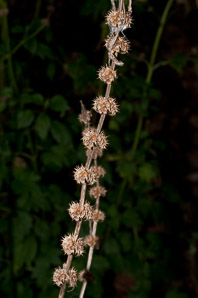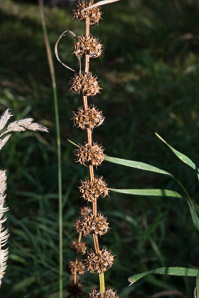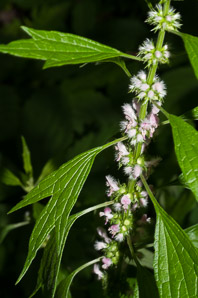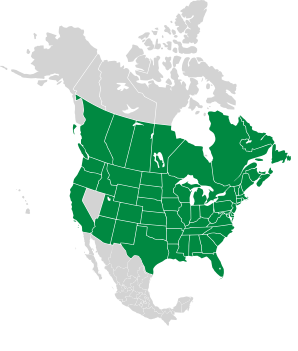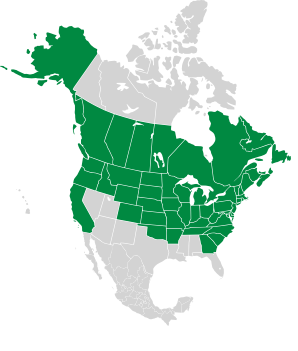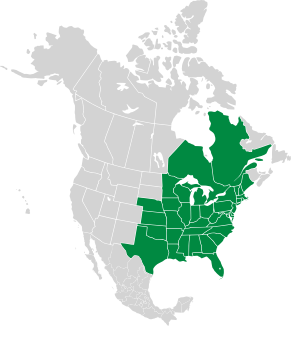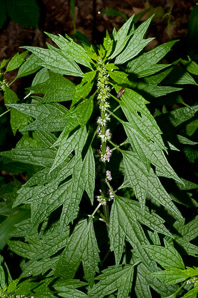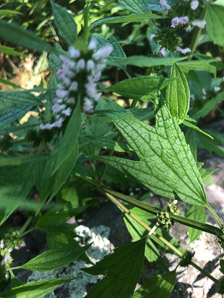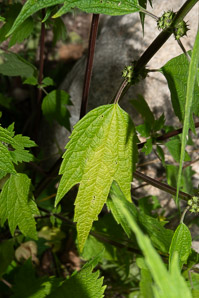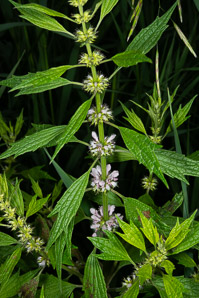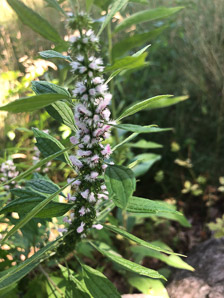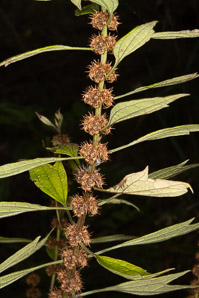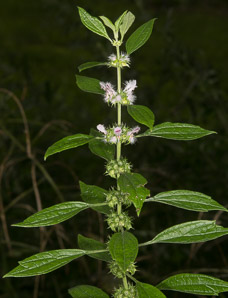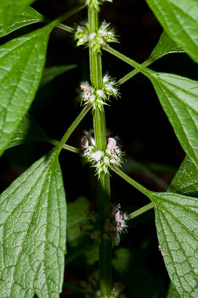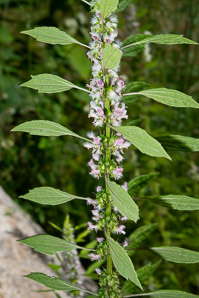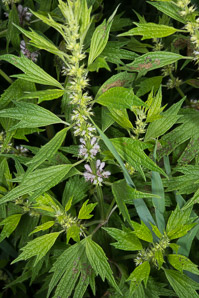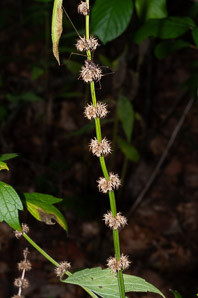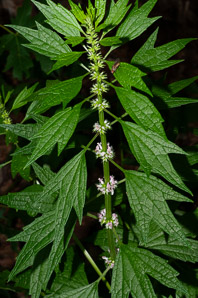
|
Leonurus cardiaca L. Motherwort, lion’s tail, heartwort
Motherwort, meaning simply "mother plant," is named for its long use to treat a variety of medical problems for women. It is a native of central Asia, but it was brought to many other places and is now found worldwide. In some localities it is considered an invasive species. It prefers woodland borders, disturbed open woodlands, and partially shaded yard edges. Plants: Plants are 2-3′ (60-100 cm) high. The stems are square in cross-section. Leaves: Leaves are opposite. Pairs of leaves extend from the stem every inch or so, in alternating directions exactly at right angles to each other, looking almost unnaturally orderly. Leaves are dark green, and are 2-4″ (5-10 cm) long. Younger leaves have three pointed tips, while older ones are further divided. Flowers: Between each pair of leaves, a tuft of small pink-purple flowers appear directly on the stem, becoming more closely spaced near the top. Fruits: Each flower becomes 4 reddish brown or brown nutlets. Each nutlet is 3-sided. Medical: Traditionally motherwort served as a uterine tonic and a preventative for uterine infection in women. It contains a mild vasodilator, lowering blood pressure slightly and reducing heart rate. It has also been variously used as a sedative, to increase longevity, a "promoter" of menstruation, a blood thinner, a diuretic, a tonic for fevers, rheumatism, bronchitis, asthma, and even postpartum depression. Although motherwort does have a mild cardiac effect, none of these uses have been confirmed.[1] Motherwort can be confused with members of Lycopus, the water-horehounds. Here are some comparisons. |
9/19/2010 · Nashua River Rail Trail, Hollis, New Hampshire · ≈ 5 × 8″ (13 × 19 cm) 8/27/2015 · Beaver Brook Conservation Area, Hollis, New Hampshire · ≈ 5 × 8″ (13 × 19 cm) 6/17/2010 · Mt. Lebanon St., Pepperell, Massachusetts · ≈ 4 × 6″ (10 × 15 cm) |
||||||||||||||||||||||||||||
|
| |||||||||||||||||||||||||||||
Lycopus americanus |
Lycopus uniflorus |
Lycopus virginicus |
|||||||||||||||||||||||||||
|---|---|---|---|---|---|---|---|---|---|---|---|---|---|---|---|---|---|---|---|---|---|---|---|---|---|---|---|---|---|
| Common Name |  |
 |
 |
||||||||||||||||||||||||||
| Plant | 1-3′ (30-91 cm) tall, unbranched or sparingly branched, sometimes sprawling. The main stem is four-angled and ridged, and hairless or nearly so. | 4-20″ (10-50 cm) tall, usually straight or with a few branches. Stems are four-angled and almost hairless. | 1-3′ (38-91 cm) tall, with an unbranched stem. It is erect, or sometimes leaning. Stems are roughly square in cross-section, and covered with fine hairs which may point outward or lie flat against the stem (appressed). These plants often (but not always) lack the thick tuberous roots of other water-horehounds. | ||||||||||||||||||||||||||
| Flowers | In small clusters at leaf axils. Individual flowers are ⅛″ (3.2 mm) in size, and white, with tiny purplish spots. They are tubular in shape, emerging in all directions from leaf axils. | Flowers occur in dense clusters at leaf axils. They are tubular, reaching in every direction from the leaf axil, and about ⅛″ (3.2 mm) around at the end. | Flowers appear in tight clusters at leaf axils. They are tubular in shape, and each is about ⅜″ (1 cm) long × ⅛″ (3.2 mm) in diameter. They emerge in all directions from the axil. Flowers are white, with a few pink spots. | ||||||||||||||||||||||||||
| Leaves | Lower leaves are deeply lobed, and up to 3½″ (8.9 cm) long × 1½″ (3.8 cm) wide. Leaves are narrowly oval, narrowly oblong, or linear. They are opposite, becoming smaller near the top, and coarsely toothed. Upper leaf surfaces are typically hairless. | Up to 3″ (7.6 cm) long × 1″ (2.5 cm) wide. They are hairless or nearly so, with 2-7 teeth on each side of the leaf. The leaves are opposite, and each pair are rotated 90° from the previous pair. | 1-4½″ (3-12 cm) × ⅜-1¾″ (1-5 cm). Oval or lanceolate, unlobed, with coarsely toothed edges. The lowest teeth are a little below the mid-point of each leaf. Leaves are more egg-shaped than those other water-horehounds. Leaves are dark green or purple, and opposite. Leaves nearer the bottom have a short stalk, while those near the top are attached almost directly to the stem. Upper leaf surfaces are nearly hairless, while lower surfaces have a hairy central vein and may have fine hairs elsewhere. | ||||||||||||||||||||||||||
| Fruit | Nutlets are in groups of four, together forming a square shape. Each is 1/32-1/16″ (1.2-1.7 mm) long. | Nutlets are 1/32-1/16″ (1-2 mm), in groups of four. | Each flower is replaced by four small nutlets, packed in roughly the shape of a square. Nutlets are 1/32-1/16″ (1.3-2 mm) × ~1/32″ (0.7-1.3 mm). | ||||||||||||||||||||||||||
| Range/ Zones |
|
|
|
||||||||||||||||||||||||||
| Habitats | Lake and river shores, and wetland edges. | Wet areas such shores, swamps, marshes, wet meadows, and stream banks. | River banks, floodplains, wet meadows, clearings, and shores. | ||||||||||||||||||||||||||
| Type | Wild | Wild | Wild | ||||||||||||||||||||||||||
| Occurrence | |||||||||||||||||||||||||||||
Leonurus cardiaca

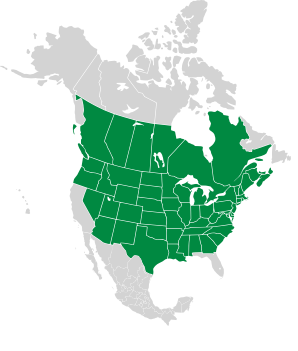
Online References:
Vascular Plants of the Gila Wilderness
SEINet—the Southwest Environmental Information Network
6/4/2010 · Nashua River Rail Trail, Ayer, Massachusetts · ≈ 9 × 14″ (23 × 35 cm) 
7/9/2019 · Beaver Brook Conservation Area, Hollis, New Hampshire 
7/23/2015 · Beaver Brook Conservation Area, Hollis, New Hampshire · ≈ 6 × 9″ (16 × 23 cm) 
6/18/2015 · Beaver Brook Conservation Area, Hollis, New Hampshire · ≈ 6 × 9″ (15 × 22 cm) 
7/9/2019 · Beaver Brook Conservation Area, Hollis, New Hampshire 
8/17/2019 · Beaver Brook Conservation Area, Wildflower Trail, Hollis, New Hampshire · ≈ 4½ × 7″ (12 × 18 cm) 
9/22/2013 · Squannacook River Wildlife Management Area, off route 119, Townsend, Massachusetts · ≈ 7 × 10″ (16 × 25 cm) 
1From susunweed.com, a commercial purveyor of herbal remedies
Leonurus cardiaca description by Thomas H. Kent, last updated 19 Aug 2023.
© FloraFinder.org. All rights reserved.
7/28/2017 · Porcupine Trail, Beaver Brook Conservation Area, Hollis, New Hampshire · ≈ 5 × 8″ (13 × 20 cm) 
6/4/2010 · Nashua River Rail Trail, Ayer, Massachusetts · ≈ 4 × 6″ (10 × 15 cm) 
7/23/2015 · Beaver Brook Conservation Area, Hollis, New Hampshire · ≈ 5 × 8″ (13 × 19 cm) 
6/18/2015 · Beaver Brook Conservation Area, Hollis, New Hampshire · ≈ 6 × 9″ (16 × 23 cm) 
9/19/2010 · Nashua River Rail Trail, Hollis, New Hampshire · ≈ 6 × 9″ (14 × 22 cm) 
6/4/2010 · Nashua River Rail Trail, Ayer, Massachusetts · ≈ 7 × 11″ (18 × 27 cm) 
Range:

